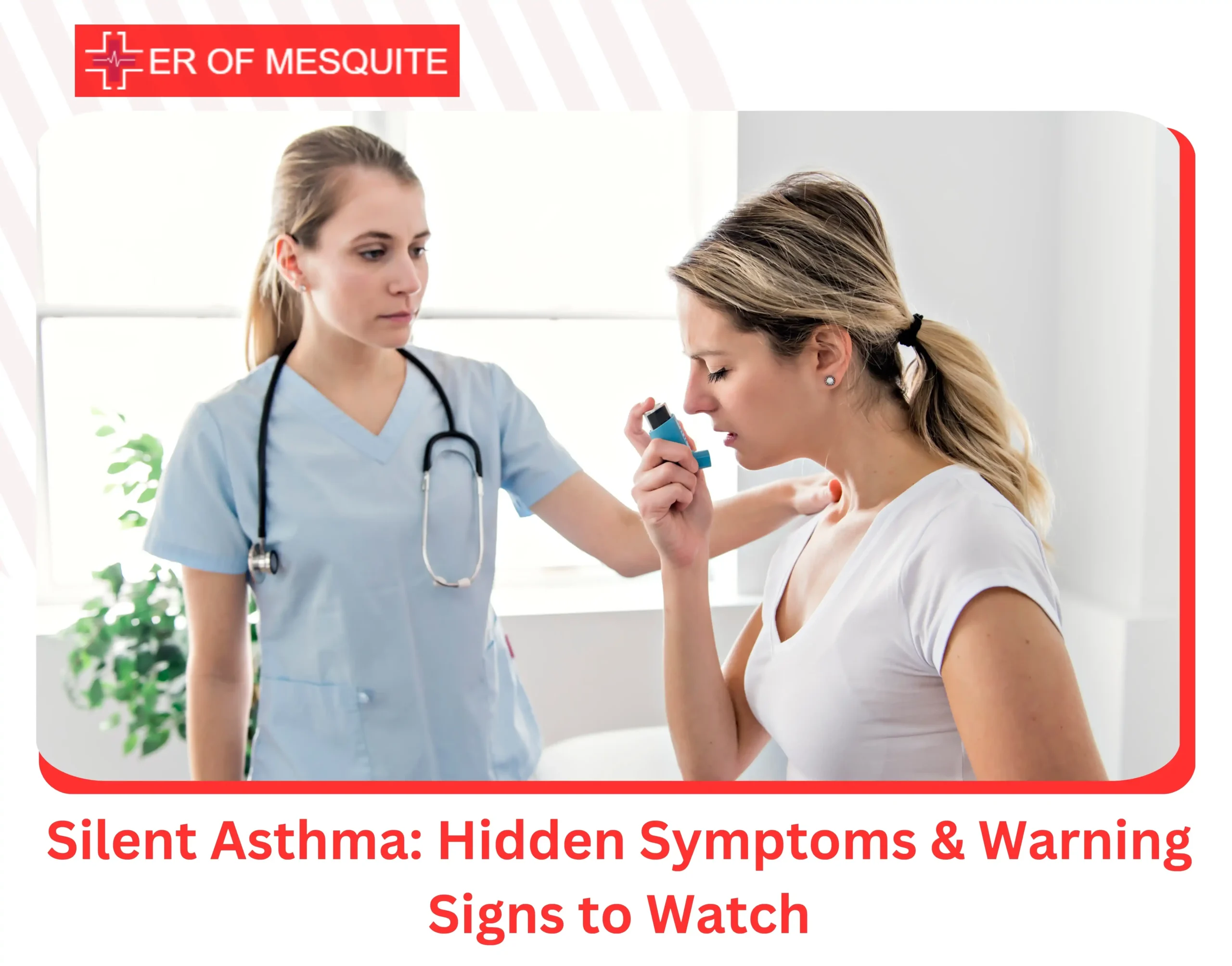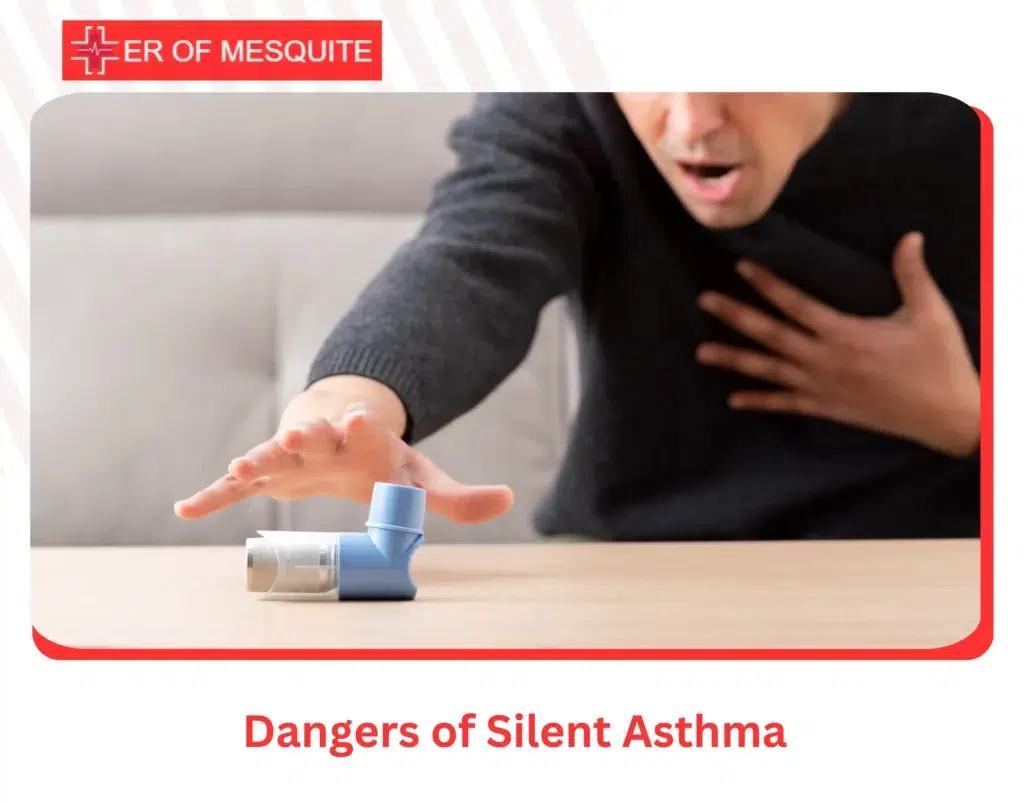Wheezing and persistent coughing are hallmark signs of asthma. Most people recognize these symptoms immediately and seek treatment. However, not all asthma presents with these obvious warning signs.
Silent asthma develops without the typical audible symptoms. Instead, it causes subtle signs: mild chest tightness, unexplained fatigue, or slight breathlessness that seems unrelated to breathing problems.
This quiet presentation creates real danger. People often dismiss these mild symptoms as stress, poor fitness, or temporary discomfort. Without proper recognition, silent asthma can progress to severe attacks. So, let’s have a look at it in detail to avoid complications.
What Is Silent Asthma?
Silent asthma occurs when airways narrow and inflame without producing the typical wheezing or persistent cough. Your breathing becomes restricted, but the restriction happens quietly.
The symptoms present as chest tightness, unexplained fatigue during normal activities, or mild breathlessness that doesn’t seem respiratory issues. Many people attribute these signs to stress, poor conditioning, or temporary illness.
Without recognizing the respiratory connection, people avoid using rescue inhalers or seeking medical evaluation. The underlying inflammation continues, potentially leading to sudden, severe attacks that require emergency treatment.
Symptoms to Watch For Silent Asthma
Silent asthma symptoms develop gradually and feel unrelated to breathing problems. People often dismiss these signs as stress, poor fitness, or temporary discomfort. Here are the main signs to look out for:
1. Shortness of Breath
If you experience difficulty breathing while walking, climbing stairs, or performing simple tasks, it may be more than just being out of shape. This slight shortness of breath is a warning sign, especially if it comes and goes or worsens as you exercise.
2. Chest Tightness or Discomfort
If you experience pressure, tightness, or a dull ache in the chest without any obvious pain, it may signal silent asthma. It may feel like something heavy lying on your chest, especially at night or in cold air.
3. Persistent Cough at Night
Unlike typical coughing episodes, silent asthma’s cough is dry and quiet, and it worsens when lying down. Coughing at night is one of the hallmarks of silent asthma that most people ignore.
4. Unusual Fatigue or Weakness
When your lungs aren’t receiving enough oxygen, you’ll feel exhausted even when you’re not doing anything. You’ll feel tired all the time with minimal tasks, indicating that your respiratory system isn’t functioning properly.
5. Reduced Exercise Tolerance
If you’ve been doing exercise efficiently before but now find it difficult or need to take breaks often, it could be because you’ve asthma, but don’t know it yet. Therefore, pay close attention if this occurs without any reasonable explanation.
6. Rapid Breathing Without Wheezing
You might not observe that you’re breathing faster than usual if you don’t make any wheezing sounds.
7. Frequent Yawning or Sighing
Constant yawning or deep sighing throughout the day may be your body’s attempt to take in more air when regular breathing isn’t enough.
8. Trouble Taking Deep Breaths
Feeling like you can’t “fill your lungs” or that your breaths are too shallow can indicate silent airway inflammation or restriction.
9. Dry Mouth or Thirst After Breathing Effort
When your body struggles to breathe properly, you may experience a dry mouth or the need to drink more water, especially after speaking or mild exertion.
Who is at Risk of Silent Asthma
Silent asthma can affect anyone, but certain groups are more likely to miss the early warning signs and experience this quiet form of asthma. Understanding who is most at risk can help with early detection and prevention.
- Children and Teenagers: Toddlers and adolescents may struggle to describe how they feel and may not recognise that their breathing is abnormal.
- Older Adults: As we age, we may blame breathlessness or fatigue on getting older, not realizing these could be signs of asthma. Older adults are also more likely to have other health issues that mask or mimic asthma symptoms, making silent asthma harder to detect.
- People with Poor Symptom Awareness: Some individuals, especially those with long-term asthma, become used to mild breathing difficulties and stop noticing them. They may skip their medication or delay treatment, thinking everything is under control, even when silent symptoms are present.
Dangers of Silent Asthma
Silent asthma doesn’t always show obvious symptoms and that’s exactly what makes it deadly. When symptoms are subtle or not apparent, the illness may gradually worsen over time, leading to unexpected and serious complications. Here are the main risks:
1. Progressive Airway Damage
Untreated inflammation gradually narrows airways and reduces lung function. This silent deterioration makes breathing increasingly difficult during normal activities and heightens sensitivity to triggers like cold air or allergens.
2. Delayed Treatment
People with silent asthma may not get care right away because they often ignore symptoms like shortness of breath or chest tightness, thinking they are just tired or stressed. If you wait too long, the inflammation in your airways may become uncontrolled, which increases the risk of an asthma attack.
2. Unpredictable Severe Attacks
An asthma attack can occur without warning. One moment you may feel good, and the next you might have trouble breathing. These silent attacks can get worse quickly and become fatal if emergency treatment is not given in time.
3. Reduced Lung Function Over Time
Even mild, untreated inflammation from silent asthma can slowly harm the lungs. This can cause breathing difficulties that last a long time, lower quality of life, and increased sensitivity to allergens, including cold air, smoke, and dust.
Spot Silent Asthma Attack Signs Before It’s Too Late
Silent asthma requires heightened awareness because subtle symptoms often go unrecognized. If you experience unexplained fatigue, chest tightness, or exercise intolerance, consider respiratory evaluation rather than dismissing these signs as stress or poor conditioning.
Track your symptoms, especially during physical activity or cold air exposure. When patterns emerge, consult a healthcare provider for proper assessment. Early recognition prevents progressive airway damage and ensures you receive appropriate treatment before symptoms escalate into serious breathing emergencies.
FAQs: Silent Asthma
How do you know if you have silent asthma?
Silent asthma presents as unexplained fatigue, chest tightness, exercise intolerance, or shortness of breath during routine activities. Unlike typical asthma, you won’t hear wheezing or experience obvious coughing fits.
Can you have asthma without wheezing?
Yes. Silent asthma occurs when airways narrow without producing audible wheezing sounds. Symptoms of asthma without wheezing include subtle breathing difficulty, chest pressure, and reduced exercise tolerance that people often dismiss as stress.
How is silent asthma diagnosed?
Doctors use lung function tests, medical history review, and symptom tracking to diagnose silent asthma. Spirometry tests measure airflow restriction even when obvious breathing sounds are absent.
Is silent asthma dangerous?
Silent asthma can be more dangerous than typical asthma because symptoms go unrecognized. Untreated airway inflammation progresses, potentially leading to sudden severe attacks and long-term lung damage.



